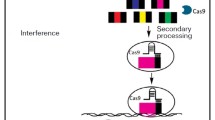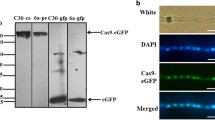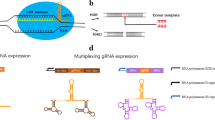Abstract
In recent years, a variety of genetic tools have been developed and applied to various filamentous fungi, which are widely applied in agriculture and the food industry. However, the low efficiency of gene targeting has for many years hampered studies on functional genomics in this important group of microorganisms. The emergence of CRISPR/Cas9 genome-editing technology has sparked a revolution in genetic research due to its high efficiency, versatility, and easy operation and opened the door for the discovery and exploitation of many new natural products. Although the application of the CRISPR/Cas9 system in filamentous fungi is still in its infancy compared to its common use in E. coli, yeasts, and mammals, the deep development of this system will certainly drive the exploitation of fungal diversity. In this review, we summarize the research progress on CRISPR/Cas9 systems in filamentous fungi and finally highlight further prospects in this area.


Similar content being viewed by others
References
Andersen MR, Nielsen JB, Klitgaard A, Petersen LM, Zachariasen M, Hansen TJ, Blicher LH, Gotfredsen CH, Larsen TO, Nielsen KF, Mortensen UH (2013) Accurate prediction of secondary metabolite gene clusters in filamentous fungi. Proc Natl Acad Sci U S A 110:E99–E107
Arazoe T, Ogawa T, Miyoshi K, Yamato T, Ohsato S, Sakuma T, Kuwata S (2015) Tailor-made talen system for highly efficient targeted gene replacement in the rice blast fungus. Biotechnol Bioeng 112:1335–1342
Auer TO, Duroure K, Concordet JP, Del BF (2014) CRISPR/Cas9-mediated conversion of Egfp-into Gal4-transgenic lines in zebrafish. Nat Protoc 9:2823–2840
Chung ME, Yeh I, Sung LY, Wu MY, Chao YP, Ng IS, Hu YC (2017) Enhanced integration of large DNA into E. coli chromosome by CRISPR/Cas9. Biotechnol Bioeng 114:172–183
Chylinski K, Le RA, Charpentier E (2013) The tracrRNA and Cas9 families of type II CRISPR-Cas immunity systems. RNA Biol 10:726–737
Cong L, Ran FA, Cox D, Lin S, Barretto R, Habib N (2013) Multiplex genome engineering using CRISPR-Cas systems. Science 339:197–217
Dufossé L, Fouillaud M, Caro Y, Mapari SA, Sutthiwong N (2014) Filamentous fungi are large-scale producers of pigments and colorants for the food industry. Curr Opin Biotechnol 26:56–61
Dwiarti L, Otsuka M, Miura S, Yaguchi M, Okabe M (2007) Itaconic acid production using sago starch hydrolysate by Aspergillus terreus Tn484-m1. Bioresour Technol 98:3329–3337
Dyal SD, Bouzidi L, Narine SS (2005) Maximizing the production of γ-linolenic acid in Mortierella ramanniana var. ramanniana as a function of ph, temperature and carbon source, nitrogen source, metal ions and oil supplementation. Food Res Int 38:815–829
Estrela R, Cate JHD (2016) Energy biotechnology in the CRISPR-Cas9 era. Curr Opin Biotechnol 38:79–84
Fakas S, Čertik M, Papanikolaou S, Aggelis G, Komaitis M, Galiotou-Panayotou M (2008) γ-Linolenic acid production by Cunninghamella echinulata, growing on complex organic nitrogen sources. Bioresour Technol 99:5986–5990
Fang H, Xia L (2015) Cellulase production by recombinant Trichoderma reesei, and its application in enzymatic hydrolysis of agricultural residues. Fuel 143:211–216
Fang YF, Tyler BM (2015) Efficient disruption and replacement of an effector gene in the Oomycete Phytophthora sojae using CRISPR/Cas9. Mol Plant Pathol 17:127–139
Francis F, Sabu A, Nampoothiri KM, Ramachandran S, Ghosh S, Szakacs G, Pandey A (2003) Use of response surface methodology for optimizing process parameters for the production of α-amylase by Aspergillus oryzae. Biochem Eng J 15:107–115
Fu YQ, Yin LF, Zhu HY, Jiang R (2016) High-efficiency l-lactic acid production by Rhizopus oryzae using a novel modified one-step fermentation strategy. Bioresour Technol 218:410–417
Fuller KK, Chen S, Loros JJ, Dunlap JC (2015) Development of the CRISPR/Cas9 system for targeted gene disruption in Aspergillus fumigatus. Eukaryot Cell 25:709–712
Gao YB, Zhao YD (2015) Self-processing of ribozyme-flanked RNAs into guide RNAs in vitro and in vivo for CRISPR-mediated genome editing. J Integr Plant Biol 56:343–349
Gao YB, Zhang Y, Zhang D, Dai XH, Estelle M, Zhao YD (2015) Auxin binding protein (ABP1) is not required for either auxin signaling or Arabidopsis development. Proc Natl Acad Sci U S A 112:2275–2280
Guilinger JP, Thompson DB, Liu DR (2014) Fusion of catalytically inactive Cas9 to FokI nuclease improves the specificity of genome modification. Nat Biotechnol 32:577–582
Haft DH, Selengut J, Mongodin EF, Nelson KE (2005) A guild of 45 CRISPR-associated (Cas) protein families and multiple CRISPR-Cas subtypes exist in prokaryotic genomes. PLoS Comput Biol 1:e60
Harris LJ, Margaret B, Anne J, Danielle S, Thérèse O (2016) Host-preferential Fusarium graminearum gene expression during infection of wheat, barley, and maize. Fungal Biol 120:111–123
Bachu R, Bergareche I, Chasin LA (2015) CRISPR-Cas targeted plasmid integration into mammalian cells via non-homologous end joining. Biotechnol Bioeng 112:2154–2162
Ji XJ, Reng LJ, Nie ZK, Huang H, Ouyang PK (2014) Fungal arachidonic acid-rich oil: research, development and industrialization. Crit Rev Biotechnol 34:197–214
Jia HG, Wang N (2014) Targeted genome editing of sweet orange using Cas9/sgRNA. PLoS One 9:e93806
Jiang D, Zhu W, Wang Y, Sun C, Zhang KQ, Yang J (2013) Molecular tools for functional genomics in filamentous fungi: recent advances and new strategies. Biotechnol Adv 31:1562–1574
Jinek M, Chylinski K, Fonfara I, Hauer M, Doudna JA, Charpentier E (2012) A programmable dual-Rna-guided DNA endonuclease in adaptive bacterial immunity. Science 337:816–821
Katayama T, Tanaka Y, Okabe T, Nakamura H, Fujii W, Kitamoto K, Maruyama J (2016) Development of a genome editing technique using the CRISPR/Cas system in the industrial filamentous fungus Aspergillus oryzae. Biotechnol Lett 38:637–642
Kück U, Hoff B (2010) New tools for the genetic manipulation of filamentous fungi. Appl Microbiol Biotechnol 86:51–62
Kuivanen J, Wang YJ, Richard P (2016) Engineering Aspergillus niger for galactaric acid production: elimination of galactaric acid catabolism by using RNA sequencing and CRISPR/Cas9. Microb Cell Fact 15:210–219
Kuscu C, Arslan S, Singh R, Thorpe J, Adli M (2014) Genome-wide analysis reveals characteristics of off-target sites bound by the Cas9 endonuclease. Nat Biotechnol 32:677–683
Kao PH, Ng IS (2017) CRISPRi mediated phosphoenolpyruvate carboxylase regulation to enhance the production of lipid in Chlamydomonas reinhardtii. Bioresour Technol. https://doi.org/10.1016/j.biortech.2017.04.111
Lecellier A, Gaydou V, Mounier J, Hermet A, Castrec L, Barbier G, Ablain W, Manfait M, Toubas D, Sockalingum GD (2015) Implementation of an FTIR spectral library of 486 filamentous fungi strains for rapid identification of molds. Food Microbiol 45:126–134
Lee J, Chung J, Kim HM, Kim D, Kim H (2016) Designed nucleases for targeted genome editing. Plant Biotechnol J 14:448–462
Liu R, Chen L, Jiang YP, Zhou ZH, Zou G (2015) Efficient genome editing in filamentous fungus Trichoderma reesei using the CRISPR/Cas9 system. Cell Discov 1:15007
Liu Q, Gao R, Li J, Lin L, Zhao J, Sun W, Tian C (2017) Development of a genome-editing CRISPR/Cas9 system in thermophilic fungal Myceliophthora species and its application to hyper-cellulase production strain engineering. Biotechnol Biofuels 10:1. https://doi.org/10.1186/s13068-016-0693-9
Makarova KS, Wolf YI, Koonin EV (2013) The basic building blocks and evolution of CRISPR Cas systems. Biochem Soc Trans 41:1392–1400
Makarova KS, Haft DH, Barrangou R, Brouns SJ, Charpentier E, Horvath P, Moineau S, Mojica FJ, Wolf YI, Yakunin AF, Oost JVD, Koonin EV (2011) Evolution and classification of the CRISPR-Cas systems. Nat Rev Microbiol 9:467–477
Mali P, Yang L, Esvelt KM, Aach J, Guell M, Dicarlo JE (2013) RNA-guided human genome engineering via Cas9. Science 339:823–826
Mantzouridou FT, Naziri E (2017) Scale translation from shaken to diffused bubble aerated systems for lycopene production by Blakeslea trispora under stimulated conditions. Appl Microbiol Biotechnol 101:1845–1856
Marumo S, Katayama M, Komori E, Ozaki Y, Natsume M, Kondo S (2014) Microbial production of abscisic acid by Botrytis cinerea. Agric Biol Chem 46:1967–1968
Mashimo T (2014) Gene targeting technologies in rats: zinc finger nucleases, transcription activator-like effector nucleases, and clustered regularly interspaced short palindromic repeats. Develop Growth Differ 56:46–52
Matsu-Ura T, Baek M, Kwon J, Hong C (2015) Efficient gene editing in Neurospora crassa with CRISPR technology. Fungal Biol Biotechnol 2:4. https://doi.org/10.1186/s40694-015-0015-1
Mishra NC, Tatum EL (1973) Non-mendelian inheritance of DNA-induced inositol independence in Neurospora. Proc Natl Acad Sci U S A 70:3875–3879
Mo X, Kang Y, Yan J, Liu J, Bi Y, Zhen K (2002) Production of linolenic acid by Mortierella isabellina grown on octadecanol. Curr Microbiol 44:141–144
Nanou K, Roukas T (2016) Waste cooking oil: a new substrate for carotene production by Blakeslea trispora in submerged fermentation. Bioresour Technol 203:198–203
Ng IS, Hung YH, Kao PH, Zhou Y, Zhang X (2016) CRISPR/Cas9 nuclease cleavage enables marker-free genome editing in Escherichia coli: a sequential study. J Taiwan Inst Chem Eng 68:31–39
Nielsen ML, Isbrandt T, Rasmussen KB, Thrane U, Hoof JB, Larsen TO, Mortensen UH (2017) Genes linked to production of secondary metabolites in Talaromyces atroroseus revealed using CRISPR/Cas9. PLoS One 12:e0169712
Nissim L, Perli SD, Fridkin A, Perezpinera P, Lu TK (2014) Multiplexed and programmable regulation of gene networks with an integrated RNA and CRISPR/Cas toolkit in human cells. Mol Cell 54:698–710
Nødvig CS, Nielsen JB, Kogle ME, Mortensen UH (2015) A CRISPR/Cas9 system for genetic engineering of filamentous fungi. PLoS One 10:e0133085
Pohl C, Kiel JA, Driessen AJ, Bovenberg RA, Nygard Y (2016) CRISPR/Cas9 based genome editing of Penicillium chrysogenum. ACS Synth Biol 5:754–764
Qin H, Xiao H, Zou G, Zhou Z, Zhong JJ (2017) CRISPR-Cas9 assisted gene disruption in the higher fungus Ganoderma species. Process Biochem 56:57–61
Ran FA, Hsu PD, Lin CY, Gootenberg JS, Konermann S, Trevino A, Scott DA, Lnoue A, Matoba S, Zhang Y, Zhang F (2013) Double nicking by RNA-guided CRISPR Cas9 for enhanced genome editing specificity. Cell 154:1380–1389
Ryan OW, Cate JH (2014) Multiplex engineering of industrial yeast genomes using CRISPRm. Methods Enzymol 546:473–489
Schuster M, Schweizer G, Reissmann S, Reissmannet S, Kahmann R (2016) Genome editing in Ustilago maydis using the CRISPR–Cas system. Fungal Genet Biol 89:3–9
Shi TQ, Peng H, Zeng SY, Ji RY, Shi K, Huang H, Ji XJ (2017) Microbial production of plant hormones: opportunities and challenges. Bioengineered 8:124–128
Tang WJ, Pan A, Lu HZ, Xia JY, Zhuang YP, Zhang SL, Chu J, Noorman H (2015) Improvement of glucoamylase production using axial impellers with low power consumption and homogeneous mass transfer. Biochem Eng J 99:167–176
Thrane U, Anderson B, Frisvad JC, Smedsgaard J (2007) The exo-metabolome in filamentous fungi. Top Curr Genet 18:235–252
Upadhyay SK, Kumar J, Alok A, Tuli R (2013) RNA-guided genome editing for target gene mutations in wheat. G3-Genes Genom Genet 3:2233–2238
Waltz E (2016) Gene-edited CRISPR mushroom escapes US regulation. Nature 532:293
Ward OP (2012) Production of recombinant proteins by filamentous fungi. Biotechnol Adv 30:1119–1139
Weber J, Valiante V, Nødvig CS, Mattern DJ, Slotkowski RA, Mortensen UH, Brakhage AA (2016) Functional reconstitution of a fungal natural product gene cluster by advanced genome editing. ACS Synth Biol 6:62–68
Weld RJ, Plummer KM, Carpenter MA, Ridgway HJ (2006) Approaches to functional genomics in filamentous fungi. Cell Res 16:31–44
Weyda I, Yang L, Vang J, Ahring BK, Lübeck M, Lübeck PS (2017) A comparison of Agrobacterium-mediated transformation and protoplast-mediated transformation with CRISPR/Cas9 and bipartite gene targeting substrates, as effective gene targeting tools for Aspergillus carbonarius. J Microbiol Methods 135:26–34
Wu Z, Feng G (2015) Progress of application and off-target effects of CRISPR/Cas9. Heredi 37:1003–1010
Xu Q, Li S, Huang H, Wen J (2012) Key technologies for the industrial production of fumaric acid by fermentation. Biotechnol Adv 30:1685–1696
Xu X, Zhang X, Wu Z, Wang Z (2015) Accumulation of yellow monascus, pigments by extractive fermentation in nonionic surfactant micelle aqueous solution. Appl Microbiol Biotechnol 99:1173–1180
Yang MQ, Athey BD, Arabnia HR, Sung AH, Liu Q, Yang JY, Mao JH, Deng YP (2009) High-throughput next-generation sequencing technologies foster new cutting-edge computing techniques in bioinformatics. BMC Genomics 10:1–3
Yin CM, Fan XZ, Shi DF, Gao H (2017) CRISPR/Cas genome editing technology and its application in fungi. Biotechnol Bull 33:58–65
Yu J, Cleveland TE, Nierman WC, Bennett JW (2005) Aspergillus flavus genomics: gateway to human and animal health, food safety, and crop resistance to diseases. Rev Iberoam Micol 22:194–202
Zhang C, Meng X, Wei X, Lu L (2015) Highly efficient CRISPR mutagenesis by microhomology-mediated end joining in Aspergillus fumigatus. Fungal Genet Biol 86:47–57
Zhang Y, Luan X, Zhang H, Garre V, Song Y, Ratledge C (2017) Improved γ-linolenic acid production in Mucor circinelloides by homologous overexpressing of delta-12 and delta-6 desaturases. Microb Cell Factories 16:113. https://doi.org/10.1186/s12934-017-0723-8
Zhou PP, Meng J, Bao J (2017) Fermentative production of high titer citric acid from corn stover feedstock after dry dilute acid pretreatment and biodetoxification. Bioresour Technol 224:563–572
Funding
This work was financially supported by the National Natural Science Foundation of China (Nos. 21376002, 21476111 and 21776131), the Jiangsu Province Natural Science Foundation of China (No. BK20131405), the Program for Innovative Research Team in University of Jiangsu Province, and the Priority Academic Program Development of Jiangsu Higher Education Institutions.
Author information
Authors and Affiliations
Corresponding author
Ethics declarations
Conflict of interest
The authors declare that they have no conflict of interest.
Rights and permissions
About this article
Cite this article
Shi, TQ., Liu, GN., Ji, RY. et al. CRISPR/Cas9-based genome editing of the filamentous fungi: the state of the art. Appl Microbiol Biotechnol 101, 7435–7443 (2017). https://doi.org/10.1007/s00253-017-8497-9
Received:
Revised:
Accepted:
Published:
Issue Date:
DOI: https://doi.org/10.1007/s00253-017-8497-9




